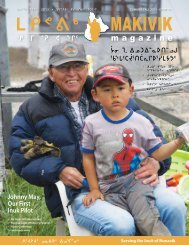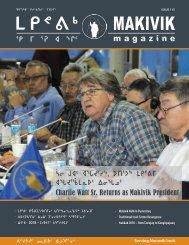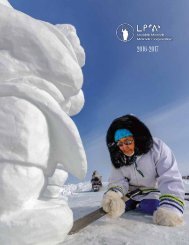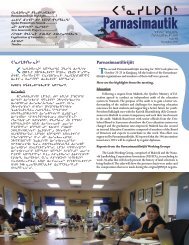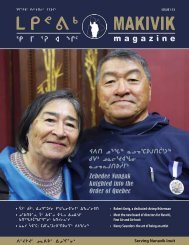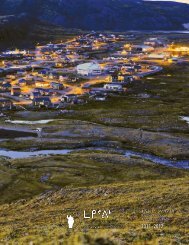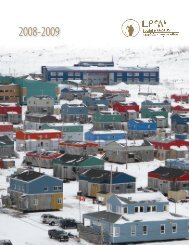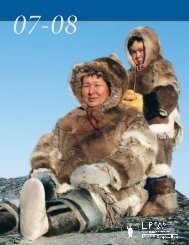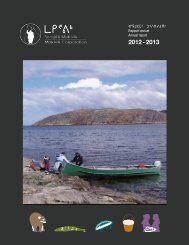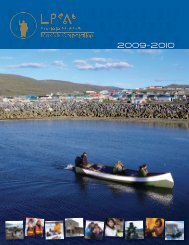2013-2014 Makivik Annual Report
The 2014 Makivik Annual Report
The 2014 Makivik Annual Report
Create successful ePaper yourself
Turn your PDF publications into a flip-book with our unique Google optimized e-Paper software.
ᐊᖓᔪᕐᖄᑉ ᑐᖓᓕᖓ ᐱᑦᓴᖑᕈᓐᓇᑐᓕᕆᓂᕐᓄᑦ ᐱᒍᑦᔨᕕᒻᒥ<br />
Vice-President for Renewable Resources<br />
Vice-président aux ressources renouvelables<br />
ᐋᑕᒥ ᑎᓖᓪ ᐊᓚᑯ<br />
ᐊᖓᔪᕐᖄᑉ ᑐᖓᓕᖓ ᐱᑦᓴᖑᕈᓐᓇᑐᓕᕆᓂᕐᓄᑦ ᐱᒍᑦᔨᕕᒻᒥ<br />
ᐊᖓᔪᕐᖄᒧᑦ ᑐᖓᓕᕆᔭᐅᑦᓱᖓ ᐱᔭᑦᓴᖁᑎᖃᕐᐳᖓ ᓂᕐᔪᑎᓕᕆᓂᕐᓂᓗ ᐱᑦᓴᖑᕈᓐᓇᑐᓂᓪᓗ<br />
ᐱᕙᓪᓕᐊᑎᑦᓯᓂᕐᓄᑦ. ᖁᕕᐊᓱᒻᒪᕆᑉᐳᖓ ᓄᓇᕕᒻᒥᐅᓄᑦ ᐃᓄᓐᓄᑦ ᑐᓴᕐᑕᐅᑎᑦᓯᒋᐊᒥᒃ<br />
ᐱᑦᔪᔨᕕᐅᑉ ᐊᖓᔪᕐᖃᐅᕕᒻᒪ ᐱᔭᖃᕈᑎᒋᓚᐅᕐᑕᖏᓐᓂᒃ ᑕᒡᒐᓂ ᑮᓇᐅᔭᕐᑐᓇᒃᑯᑦ ᐊᕐᕌᒍᑦᑎᓂ.<br />
ᑎᓕᐅᕆᒍᑎᖃᕐᐳᖓᓗ ᐊᑐᐊᕐᓯᔪᑦ ᕿᒥᕐᕈᓯᐊᓚᖓᖁᑦᓱᒋᑦ ᑖᒃᑯᓂᖓ ᑐᓴᕐᑎᓯᒍᑎᓂᒃ<br />
ᑐᑭᓯᑦᓯᐊᖁᓪᓗᒋᑦ ᑲᒃᑯᓂᖓ ᐅᖄᔭᐅᔪᓂᒃ.<br />
©TEEVI MACKAY/MAKIVIK<br />
ᑐᑦᑐᓂᒃ ᐊᐅᓚᑦᓯᓂᕐᓄᑦ ᐊᓪᓚᖁᑏᑦ ᓱᓕ ᓵᖕᖓᓯᒍᑎᑦᓴᑕᓕᒻᒪᕆᐅᕗᑦ ᐱᒃᑲᑕᐅᔪᓂᒃ <strong>2014</strong>-<br />
ᖑᑎᓪᓗᒍ ᖃᖓᑦᑕᔫᒃᑯᑦ/ᑎᖕᒥᔫᒃᑯᑦ ᑭᓯᑦᓯᓂᐅᓚᐅᔪᔪᓄᑦ ᒥᑦᓴᐅᓵᕆᓂᐅᓯᑦᓱᑎᓪᓗ ᐅᓄᕐᓂᖃᓕᕆᐊᖏᑦ<br />
14,200 ᒥᑦᓯᑎᓐᓂ, ᑖᒃᑯᐊ ᑌᒣᓪᓗᐊᓕᕐᑎᓗᒋᑦ ᑕᑯᑦᓴᐅᓕᕐᑐᖅ ᑲᖏᕐᓱᐊᓗᒃᔪᐊᑉ ᑐᑦᑐᖏᑦ<br />
ᓱᓕ ᐃᑭᓕᕙᓪᓕᐊᑐᐃᓐᓇᖏᓐᓇᕆᐊᖏᑦ. ᑌᒪᓕ ᐱᔭᕇᕐᑕᐅᓚᐅᔪᖕᖏᑲᓗᐊᕐᑎᓗᒋᑦ ᖃᖓᑦᑕᔫᒃᑯᑦ/<br />
ᑎᒻᒥᔫᒃᑯᑦ ᑭᓯᑦᓯᓃᑦ ᑕᓯᐅᔭᐅᑉ ᑐᑦᑐᖏᓐᓂᒃ, ᖃᐅᔨᔭᐅᑎᓯᒪᔭᖏᑦ ᐃᓄᐃᑦ ᑐᑦᑐᓯᐅᓲᑦ <strong>2014</strong>-<br />
ᒥᓗ ᐊᓪᓚᓯᒪᔪᖕᖑᐃᒍᑎᐅᓯᒪᔪᑦ ᐱᓇᓱᑦᑕᐅᓱᑎᒃ ᓄᓇᓕᕐᓚᐅᑉ ᐆᒪᔪᓂᒃ ᐃᓕᓯᒪᔪᖁᑎᖏᓐᓄᑦ<br />
ᑐᑭᓯᑎᑦᓯᒍᑎᐅᓯᒪᕗᑦ ᑖᒃᑯᐊ ᑐᑦᑐᐃᑕᐅᖅ ᐃᑭᓕᕙᓪᓕᐊᓂᖃᕐᒥᒋᐊᖏᑦ. ᓱᕐᖁᐃᑐᒥᒃ ᐃᓄᒃᒍᑎᑦᓴᓂᒃ<br />
ᐃᓄᐃᑦ ᑐᑦᑐᓂᒃ ᐊᓐᓂᑐᐊᖃᖃᑦᑕᓂᖏᑦ ᓯᕗᓪᓕᐅᔭᐅᖏᓐᓇᕆᐊᖃᕐᐳᑦ. ᒪᑭᕝᕕᓗ ᐃᓄᑐᐃᓐᓀᓗ<br />
ᑭᒡᒐᑐᕐᑎᖏᑦ ᐊᖑᓇᓱᓐᓂᓄᓪᓗ ᐃᖃᓗᓐᓂᐊᓂᕐᓄᓗ ᒥᑭᒋᐊᕐᓂᐊᓂᕐᓄᓗ ᐊᑕᐅᑦᓯᑯᕐᑎᓯᓂᕐᓄᑦ<br />
ᑲᑎᖕᖓᔩᑦ (ᐊᓐᓂᑐᕐᕕᑯᑦ) ᐊᑕᓐᓂᐅᕈᑎᖃᖃᑦᑕᓕᕐᖁᑦ ᓄᕐᖃᑎᑕᐅᖁᔨᑦᓱᑎᒃ ᓂᕿᑦᓴᓂᐊᖕᖏᑐᑦ<br />
ᑐᑦᑐᓂᐊᕐᓂᕆᖃᑦᑕᑕᖏᓐᓂᒃ ᑕᓯᐅᔭᐅᑉ ᑐᑦᑐᖏᓐᓂᒃ. ᖃᖓᑦᑕᔫᒃᑯᑦ/ᑎᖕᒥᔫᒃᑯᑦ ᕿᑲᑐᐃᓐᓇᕙᓪᓗᑐᓂᒃ<br />
Adamie Delisle Alaku<br />
Vice-President for Renewable Resources<br />
In my capacity as vice president responsible for wildlife and resource<br />
development, it is my great pleasure to inform the Inuit of Nunavik<br />
of my department’s accomplishments over the past fiscal year. I<br />
invite readers to review other sections of this report to obtain more<br />
details on the following topics.<br />
The caribou file remains a significant challenge as results from the<br />
<strong>2014</strong> aerial survey estimating a population of 14,200 animals is clear<br />
evidence that the George River herd continues its decline. Although<br />
no aerial survey was completed of the Leaf River herd, evidence from<br />
Inuit hunters and a fall <strong>2014</strong> classification conducted by provincial<br />
biologists indicates that population is equally in decline. To ensure<br />
subsistence harvesting rights take a priority, <strong>Makivik</strong> and the Inuit<br />
representatives to the Hunting Fishing Trapping Coordinating<br />
Committee (Anniturvik) are asking for a closure of the sport hunt<br />
of Leaf River herd caribou. An aerial survey of the sedentary Torngat<br />
caribou herd was conducted through funding received by the<br />
Torngat Wildlife, Plants and Fisheries Secretariat and in collaboration<br />
with provincial governments as well as with <strong>Makivik</strong>, Nunatsiavut<br />
government and Parks Canada. The population estimate of 900<br />
caribou is disappointing, however as a single estimate it is uncertain<br />
whether this indicates a population at carrying capacity or in<br />
decline. Notwithstanding, it does provide information that can be<br />
utilized to guide management and harvest level decisions. This<br />
year marked an important achievement when the court of Appeals<br />
rendered their judgment in favor of the Native parties regarding<br />
breaches in the operational process of Anniturvik. Appellate court<br />
Adamie Delisle Alaku<br />
Vice-président aux ressources renouvelables<br />
À titre de vice-président responsable de la faune et du développement<br />
des ressources, j’ai le plaisir de présenter les réalisations<br />
de mon service au cours de l’exercice écoulé. J’invite les lecteurs à<br />
consulter d’autres sections de ce rapport pour plus de détails sur<br />
les sujets qui seront abordés dans les paragraphes qui suivent.<br />
Le dossier du caribou demeure un défi de taille comme en<br />
témoignent les résultats des relevés aériens effectués en <strong>2014</strong> qui<br />
confirment le déclin de la population du troupeau de la rivière<br />
George qui compte maintenant à peine 14 200 animaux. Aucun<br />
relevé aérien n’a été effectué concernant le troupeau de la rivière<br />
aux Feuilles, mais les faits rapportés par les chasseurs inuits et le<br />
classement effectué à l’automne <strong>2014</strong> par des biologistes provinciaux<br />
indiquent que la population est également en déclin. Afin de<br />
s’assurer que la chasse de subsistance ait préséance, <strong>Makivik</strong> et les<br />
représentants inuits membres du Comité conjoint de chasse, pêche<br />
et piégeage (Anniturvik) ont demandé la fermeture de la chasse<br />
sportive dans le troupeau de caribous de la rivière aux Feuilles. Un<br />
relevé aérien du troupeau de caribous sédentaires des Torngat a<br />
été réalisé grâce au financement reçu du Secrétariat Torngat de la<br />
faune, de la flore et des pêches en collaboration avec les gouvernements<br />
provinciaux, <strong>Makivik</strong>, le gouvernement du Nunatsiavut<br />
et Parcs Canada. L’estimation de la population de 900 caribous est<br />
décevante, mais cette seule donnée ne permet pas de savoir si la<br />
population est stable ou en déclin. Toutefois, cette information est<br />
utile pour guider les décisions de gestion et de niveau de récolte.<br />
Cette année a été marquée par l’importante décision de la Cour<br />
24<br />
ᒪᑭᕝᕕᒃ • <strong>Makivik</strong> Corporation • Société <strong>Makivik</strong>






